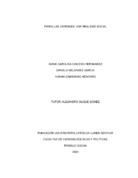Mostrar el registro sencillo del ítem
Pandillas juveniles; una realidad social
| dc.contributor.advisor | Duque Gómez, Alejandro | |
| dc.creator | Caicedo Hernández, Diana Carolina | |
| dc.creator | Meléndez García, Daniela | |
| dc.creator | Zambrano Montaño, Yurani | |
| dc.date.accessioned | 2021-10-13T19:24:20Z | |
| dc.date.available | 2021-10-13T19:24:20Z | |
| dc.date.created | 2020 | |
| dc.identifier.uri | http://hdl.handle.net/20.500.12237/2171 | |
| dc.description | El presente documento es el informe final de una investigación que se realizó entre el segundo semestre del año 2019 y el primer semestre del año 2020. El objetivo general fue el de comprender las experiencias que hacen parte del proceso de vinculación a las pandillas por parte de algunos jóvenes del barrio Tierra Blanca, ubicado en la ladera de Siloé de la ciudad de Santiago de Cali, en relación con la construcción de sus estilos de vida. Se realizaron entrevistas semi estructuradas a cuatro personas (tres hombres y una mujer); la condición para ser seleccionados era que hubieran hecho parte de alguna pandilla juvenil del barrio ya mencionado. Uno de los principales hallazgos de la investigación, fue que el involucramiento y pertenencia en dichos grupos genera en los jóvenes unos estilos de vida particulares, que genera diferencias frente otras personas en su mismo sector y rango de edad, generando unos procesos de identidad colectiva, pero aumentando su segregación y estigmatización social; de esta forma, a los miembros de las pandillas se les dificulta mucho adoptar otras formas de vida, quedando excluidos casi de manera permanente de la comunidad y ciudad donde habitan (en este caso Cali). | spa |
| dc.description.abstract | This document is the final report of an investigation carried out between the second semester of 2019 and the first semester of 2020. The general objective was to understand the experiences that are part of the process of linking to gangs by some young people from the Tierra Blanca neighborhood, located on the hillside of Siloé in the city of Santiago de Cali, in connection with the construction of their lifestyles. Semi-structured interviews were conducted with four people (three men and one woman); the condition to be selected was that they had been part of some youth gang in the aforementioned neighborhood. One of the main findings of the research was that involvement and belonging in these groups generates particular lifestyles for young people, which generates differences compared to other people in the same sector and age range, generating processes of collective identity, but increasing their segregation and social stigmatization; in this way, gang members find it very difficult to adopt other ways of life, being almost permanently excluded from the community and city where they live (in this case Cali). | spa |
| dc.format.mimetype | application/pdf | spa |
| dc.subject | Estilos de vida | spa |
| dc.subject | Prácticas grupales y sociedad | spa |
| dc.title | Pandillas juveniles; una realidad social | spa |
| dc.subject.subjectenglish | Lifestyles | spa |
| dc.subject.subjectenglish | Group practices and society | spa |
| dc.rights.accessRights | info:eu-repo/semantics/openAccess | spa |
| dc.creator.degree | Trabajadora social | spa |
Ficheros en el ítem
Este ítem aparece en la(s) siguiente(s) colección(ones)
-
Trabajo social [101]

